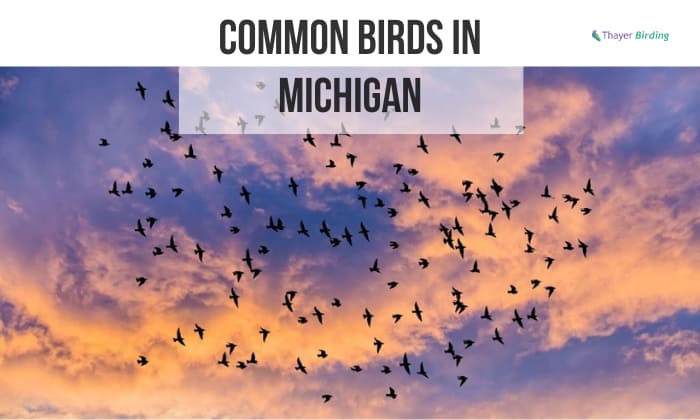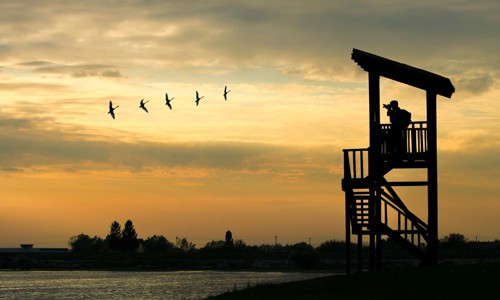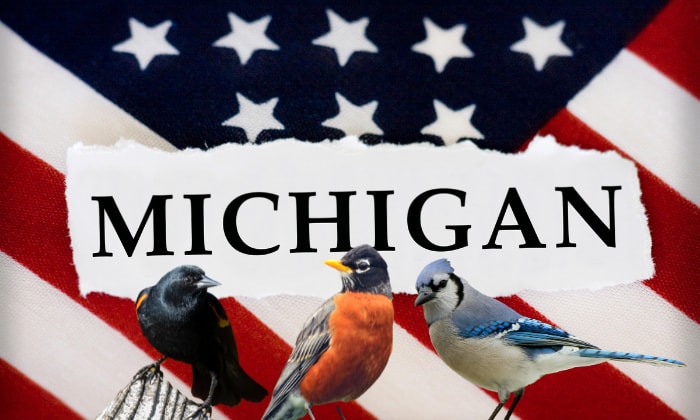There are certain birds that seem to be everywhere you look in the United States, such as the Mourning Dove and House sparrow.
However, Michigan is home to several other species that are active at different times of the year.
Common birds in Michigan year-round include the American Robin, Tufted Titmouse, Blue Jay, and the Red-bellied Woodpecker. Meanwhile, some species such as Barn swallows are only seen during breeding season.
Read on for 14 popular species and their bird identification!
Table of Contents
- Common Birds Found in Michigan
- 1. American Robin (Turdus Migratorius)
- 2. Tufted Titmouse (Baeolophus Bicolor)
- 3. Red-Bellied Woodpecker (Melanerpes Carolinus)
- 4. American Goldfinch (Spinus Tristis)
- 5. Blue Jay (Cyanocitta Cristata)
- 6. White-Breasted Nuthatch (Sitta Carolinensis)
- 7. Black-Capped Chickadee (Poecile Atricapillus)
- 8. European Starling (Sturnus Vulgaris)
- 9. Northern Flicker (Colaptes Auratus)
- 10. Chipping Sparrow (Spizella Passerina)
- 11. Barn Swallow (Hirundo Rustica)
- 12. Indigo Bunting (Passerina Cyanea)
- 13. Baltimore Oriole (Icterus Galbula)
- 14. Ruby-Throated Hummingbird (Archilochus Colubris)
- Overview of Birdwatching in Michigan
- Tips for Successful Birdwatching in Michigan
- Common Birds at Different Times in Michigan
- Conclusion
Common Birds Found in Michigan
Here are fourteen common backyard birds in Michigan and some interesting facts about each.
1. American Robin (Turdus Migratorius)

- Size: 9-11 inches
- Wingspan: 12-16 inches
- Lifespan: 2 years
- Presence in Michigan: Year-round
The American robin was declared the state bird of Michigan in 1931. Aside from being one of the most common birds, it was also the best-loved. Their song is one of the most recognizable Michigan bird calls!
American robins have dark brown bodies and deep orange chests and bellies. They are 9-11 inches long with a wingspan of 12-16 inches.
These Michigan song birds are omnivores, switching between nuts, seeds, berries, and insects depending on the season. They are prevalent both in urban areas and wild forests.
There is a popular belief that robins are early signs of spring, but this isn’t always the case. In many places, such as Michigan, they are visible all seasons!
2. Tufted Titmouse (Baeolophus Bicolor)
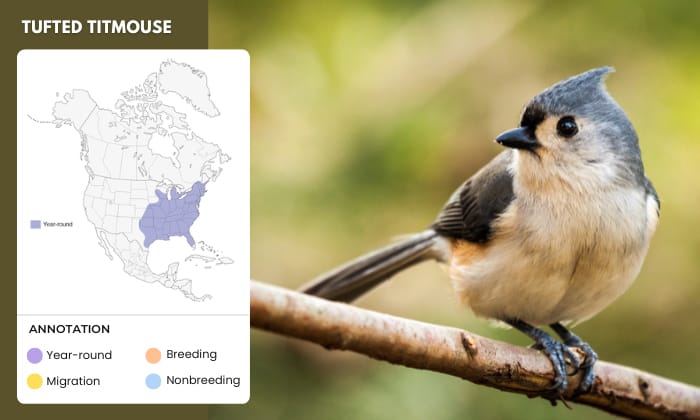
- Size: 6 inches
- Wingspan: 8-10 inches
- Lifespan: 2 years
- Presence in Michigan: Year-round
Tufted titmice are about 6 inches long with a wingspan of 8-10 inches. They have grey backs and tails, white faces and undersides, a black spot above their nose, and a reddish area under their wings.
They also have a characteristic standing tuft of hair on their heads, which inspired their name.
In the wild, these small birds in Michigan are found in forests but can frequently be spotted in populated areas, including gardens and parks.
These grey birds eat nuts, seeds, and fruit in the winter and have the amazing coordination of holding seeds steady with their feet while breaking them open with their bills. In the summer, their diet switches to insects, particularly caterpillars.
3. Red-Bellied Woodpecker (Melanerpes Carolinus)

- Size: 9-10 inches
- Wingspan: 15-18 inches
- Lifespan: 12 years
- Presence in Michigan: Year-round
Red-bellied woodpeckers are more easily identified by their bright red crowns and napes than their bellies, which are only pale red. Still, they should not be confused with the red-headed woodpecker with a solid redhead.
These birds have long bills and a black-and-white striped pattern on their backs. They are usually 9-10 inches long with a wingspan of 15-18 inches.
Red-bellied woodpeckers will always be near trees without showing much preference for specific species. However, they typically prefer decaying trees or trees with softer wood when building nests.
While they love pecking through tree trunks to search for insects, they can also catch insects midflight. They also enjoy eating fruits, nuts, and seeds.
4. American Goldfinch (Spinus Tristis)

- Size: 5 inches
- Wingspan: 8 inches
- Lifespan: 3-6 years
- Presence in Michigan: Year-round
The American Goldfinch is a bright yellow bird with a black forehead patch and wings, though females tend to have duller feathers than males. Both sexes fade to brown during winter.
The bird is 5 inches long with a wingspan of 8 inches. They are typically found in open areas such as fields, meadows, and plains, eating grains and seeds but also having the occasional insect.
The yellow bird is so popular it is the state bird of Iowa, New Jersey, and Washington State!
Goldfinches often fall victim to brown-headed cowbirds’ sneaky egg-switching tactics. One study found that 9% of American Goldfinch nests had brown-headed cowbird eggs instead of their own!
5. Blue Jay (Cyanocitta Cristata)

- Size: 9-12 inches
- Wingspan: 13-17 inches
- Lifespan: 7 years
- Presence in Michigan: Year-round
Blue Jays are songbirds with beautiful blue, black, and white mosaic-like patterns on their wings and tail. They are 9-12 inches long with a wingspan of 13-17 inches.
Blue Jays are commonly found in forests and residential areas. They mainly eat nuts and seeds but may sometimes eat insects, worms, and even eggs.
These bluebirds also love to eat ants but have a peculiar habit of rubbing the bugs against their feathers before eating them. Scientists theorize this rubbing (or “anting”) removes the ants’ formic acid.
While they are very smart birds, they can be forgetful. Sometimes, they bury caches of nuts for later and never come back. These nuts eventually grow into trees! Thanks, blue jays!
6. White-Breasted Nuthatch (Sitta Carolinensis)
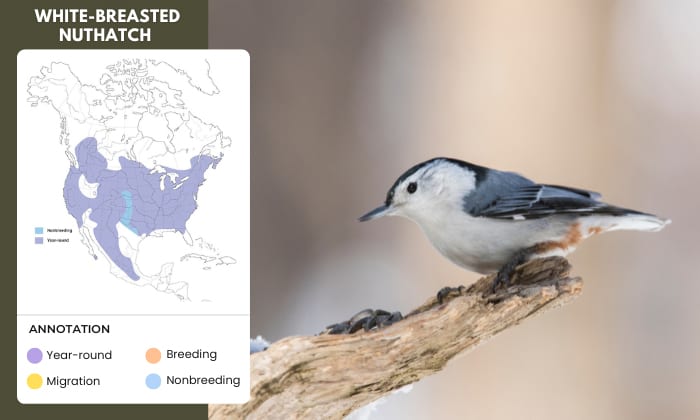
- Size: 6 inches
- Wingspan: 8-10 inches
- Lifespan: 2 years
- Presence in Michigan: Year-round
White-breasted nuthatches are small birds only 6 inches long with a wingspan of 8-10 inches. They have upper greyish-blue feathers, white undersides and faces, and reddish tinges by their legs.
These birds love seeds so much they are willing to work for them. They take nuts and acorns, which they “hatch” by wedging securely in a tree or rock crevice and crack with long beaks that curve upwards to get to the seed inside.
However, they will also gladly eat insects and whatever you offer in your feeder.
White-breasted nuthatches can be found in forests and parks with trees, frequently making their loud, nasal calls. Some people have compared their wah-wah-wah call to laughing monkeys!
7. Black-Capped Chickadee (Poecile Atricapillus)
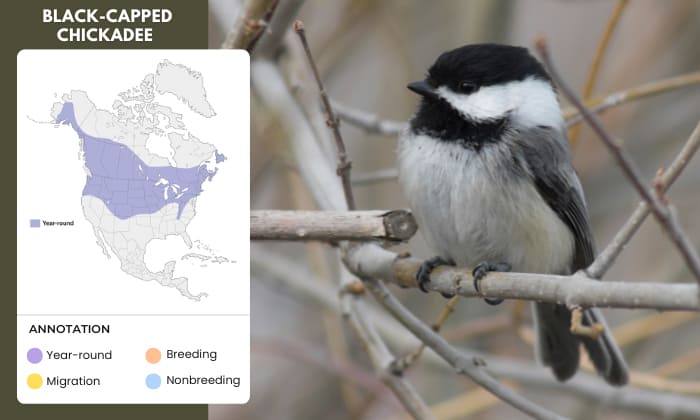
- Size: 5 inches
- Wingspan: 6-8 inches
- Lifespan: 2-3 years
- Presence in Michigan: Year-round
Black-capped chickadees are common throughout northern North America all the way up to Alaska. They are typically found in forests, but are also frequent feeder visitors.
These (almost) black and white birds are about 5 inches long with a wingspan of 6-8 inches. They have grey backs, rusty red underparts, and a black head marked by a wide horizontal white streak.
Chickadees love nuts, seeds, berries, and insects and are known for storing food for future eating.
Though these birds spend their days with a flock, they retire into a personal cavity alone every evening to sleep, even in the winter.
8. European Starling (Sturnus Vulgaris)
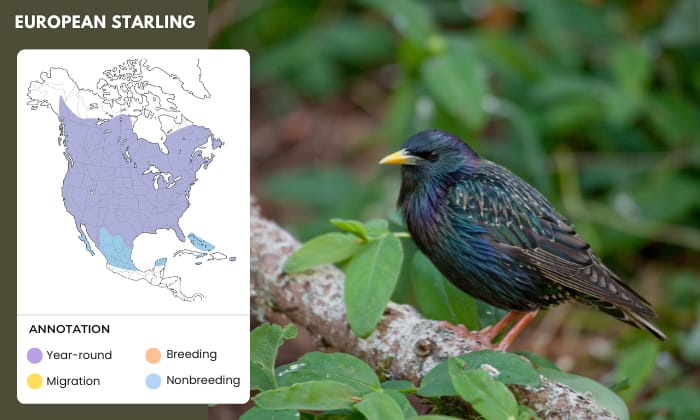
- Size: 7.5-9 inches
- Wingspan: 12-17 inches
- Lifespan: 2-3 years
- Presence in Michigan: Year-round
In his play, Henry VI, Shakespeare mentions starlings once.
This was apparently one time too many: that single sentence inspired an enthusiast to release 100 starlings in Central Park in 1890, and the rest is history.
Over the past century, European starlings have become widespread in North America, with an estimated population size of 200 million.
These birds are 7.5-9 inches long with a wingspan of 12-17 inches. They have speckled, glossy dark feathers that have a distinct metallic sheen.
European starlings are not afraid to linger around humans in areas such as parks, lawns, fields, and home gardens.
They are not picky eaters, happily eating whatever they find, from seeds, nuts, and berries to insects and even flower nectar.
9. Northern Flicker (Colaptes Auratus)

- Size: 11-14 inches
- Wingspan: 16-21 inches
- Lifespan: 5-6 years
- Presence in Michigan: Year-round except in northern Michigan
Northern flickers have grey heads with a bright red spot at the nape, light brown faces, and spotted and striped wings and tails. A black or red “mustache can distinguish males.”
While northern flickers in Michigan tend to have yellow feathers under their tails, northern flickers from western states have red under tails instead.
These birds are 11-14 inches long with a wingspan of 16-21 inches. They are often found in southeast Michigan, in areas with lots of trees where they nest inside hollow trunks.
However, these woodpeckers also enjoy walking on the ground to forage for insects, like ants and beetles.
Northern flickers communicate by drumming and can sometimes be found drumming on metal objects to produce loud sounds.
10. Chipping Sparrow (Spizella Passerina)
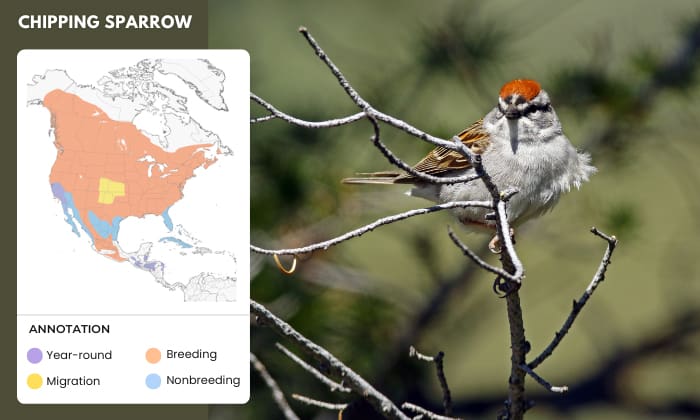
- Size: 5 inches
- Wingspan: 8 inches
- Lifespan: 4-7 years
- Presence in Michigan: Breeding season (April to August)
Chipping sparrows are made for their “chip chip” call to each other. They are typically 5 inches long with a wingspan of 8 inches.
These songbirds have white bodies, reddish brown crowns, and striped brown wings and tails. They also have a black line across their faces which becomes more prominent during the breeding season.
Chipping sparrows breed in Michigan during spring and summer but fly south for the winter to southern US states and Central America.
Regardless of season, these brown birds are nearly everywhere, such as forests, parks, roadsides, and many residential areas.
While they primarily eat seeds, these birds supplement their diets every breeding season with insects and spiders.
11. Barn Swallow (Hirundo Rustica)
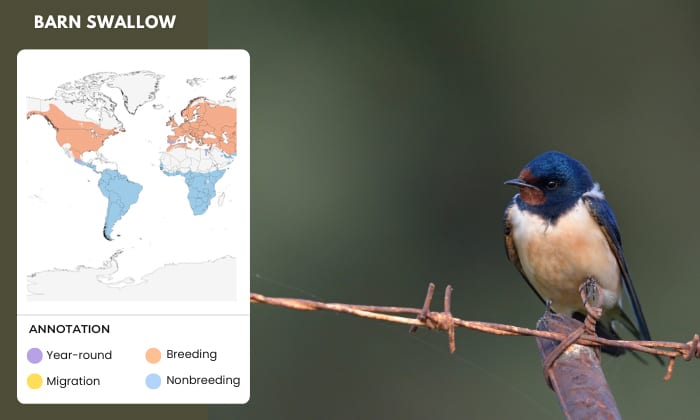
- Size: 7 inches
- Wingspan: 13 inches
- Lifespan: 4 years
- Presence in Michigan: Breeding season (April to August)
Barn swallows are colorful birds with deep blue heads and backs, tangerine chests and stomachs, dark orange faces, and gray, forked tails. They are about 7 inches long with a wingspan of 13 inches.
Despite their small size, these birds are strong travelers, sometimes migrating to places 9,000 kilometers away!
These songbirds thrive in open areas and are comfortable living in man-made structures. They are insectivores that enjoy catching and eating their prey in mid-flight.
Barn swallows are prevalent throughout the globe, present in all continents except Antarctica. Unfortunately, they are a little too many, causing many homeowners to consider them as pests as they lament droppings and nests all over their yards.
12. Indigo Bunting (Passerina Cyanea)
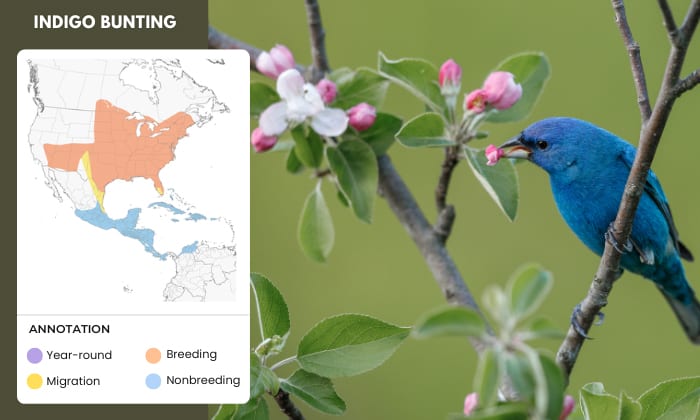
- Size: 4.5-6 inches
- Wingspan: 7-9 inches
- Lifespan: 2-3 years
- Presence in Michigan: Breeding season (May to September)
What indigo buntings look like depends on whether you see a male or female. Males display feathers in a gradient from midnight blue heads to bright blue bodies during the breeding season. They then fade to brown during winter, the females’ year-round color.
These birds are only 4.5-6 inches long, with a wingspan of 7-9 inches. They are comfortable in brushy pastures and wood edges and can be spotted perched on trees and poles, cheerfully singing during the summer.
Indigo buntings eat a mix of seeds and insects but may also eat berries and spiders.
As a migratory bird constantly on the move, indigo buntings are often seen as a symbol of freedom, independence, hope, and new beginnings.
13. Baltimore Oriole (Icterus Galbula)
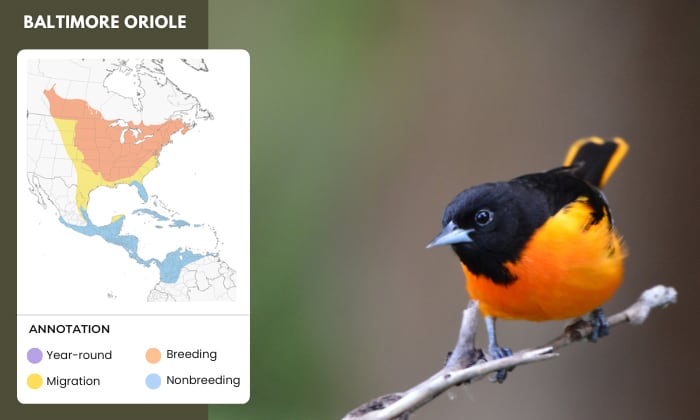
- Size: 7-9 inches
- Wingspan: 9-13 inches
- Lifespan: 11.5-14 years
- Presence in Michigan: Breeding season (April to August)
Baltimore orioles are the state bird of Maryland. They are also known as the Northern Oriole.
These birds bring Halloween to mind, having bright orange bodies and black heads and wings. They are named after a certain Lord Baltimore, who had a coat-of-arms with a similar coloring and pattern.
These orioles are 7-9 inches long with a wingspan of 9-13 inches. They breed in northeastern North America but migrate to Central America, north South America, and southern US states such as Florida for the winter.
Baltimore orioles thrive in trees where they perch in the higher branches singing and foraging for food, such as insects and fruit. However, they are willing to fly lower occasionally for more food and water.
14. Ruby-Throated Hummingbird (Archilochus Colubris)

- Size: 3 inches
- Wingspan: 4 inches
- Lifespan: 3-5 years
- Presence in Michigan: Breeding season (March to August)
Ruby-throated hummingbirds are one of the spring and summer birds of Michigan.
These rare birds are typically 3 inches long with a 4-inch wingspan. They have emerald green backs and heads and dirty white chests and bellies. The ruby-colored throat referred to in the bird’s name is only seen in males.
These tiny birds are excellent fliers, able to beat their wings between 50-200 times per second to reach speeds of 25-40 miles per hour. They also have excellent control over their flight, being able to stop instantly, hover, and easily move in all directions.
However, their flying skills come at the cost of their ground mobility. These hummingbirds’ legs are so short they can’t walk or even hop! Mostly, they can only shuffle along a perch.
Overview of Birdwatching in Michigan
Michigan is home to a lot of people and a lot of wildlife. Mostly, they enjoy the 3,000+ mile coastline along the Great Lakes which provides plenty of natural food, water, and shelter.
1. Best Spots for Birdwatching in Michigan
The best places to spot birds in Michigan are often away from densely populated places. You can also go to areas intentionally designed for guests to enjoy nature.
- Whitefish Point Bird Observatory,
- Pointe Mouillee State Game Area,
- Seney National Wildlife Refuge,
- Shiawassee National Wildlife Refuge, and
- Warren Dunes State Park.
2. Best Time for Birdwatching
In general, the best time for birdwatching is early in the morning. The saying “the early bird gets the worm” exists for a reason—birds get out early to catch worms as they squirm out for warmth!
Birds also tend to become active in the late afternoon as they eat their last meals before bedtime.
However, the best birdwatching time also depends on what types of birds you are hoping to see.
If you are looking for raptors such as hawks and falcons, head to your park in the late morning or early afternoon.
Meanwhile, night birds such as owls are active when the moon is out, but they may be more difficult to spot because of the darkness.
Water birds are active all day.
Tips for Successful Birdwatching in Michigan
As with all skills, birdwatching takes a little practice. Whether you are a beginner or regularly go birding, here are some tips to help you spot more birds.
- Avoid bright-colored clothes since this may be scary for birds. Instead, go in neutral earth tones of greens, browns, and grays.
- Avoid sudden, jerky movements and loud noises to avoid startling birds away.
- Be patient, as the birds will emerge if and when they are ready—no sooner or later.
- Study in advance. The activity will be much more enjoyable if you are familiar with the local fauna.
Common Birds at Different Times in Michigan
While some birds stay in Michigan year-round, others only drop by when the weather is warmer. Here are the best times to see specific species.
Year-Round Birds, Including Winter
- American Robin
- Blue Jay
- Black-capped Chickadee
- Northern Cardinal
- Mourning Dove
- American Goldfinch
- White-breasted Nuthatch
- Red-winged Blackbird
- Downy woodpecker
Summer-Only Birds
- Northern Flicker
- Chipping Sparrow
- Barn Swallow
- Indigo Bunting
- Baltimore Oriole
- Ruby-throated Hummingbird
Conclusion
Michigan residential areas are home to many interesting birds, but taking the time to visit parks and wildlife refuges is worth it.
There are many more common birds in Michigan beyond those in this list, and it can be a fulfilling experience to add to your birding knowledge and expertise.
After all, birdwatching also gives you and your family and friends a chance to unplug from screens and enjoy natural sights, sounds, and entertainment.
And typically, any activity that gets you out of the house will be a memorable one.

George and I became friends after a birdwatching trip with our new group. And we have been enjoying every adventure together. When he told me the idea of establishing a site that shares our experiences and fun, I immediately agreed. After trials and errors, here we have Thayerbirding.


